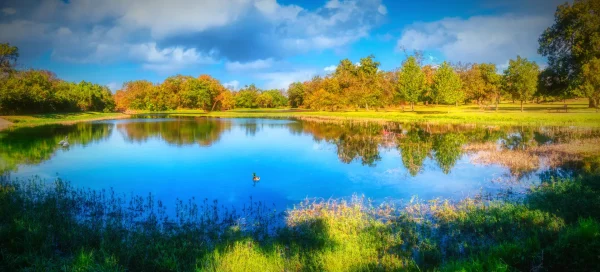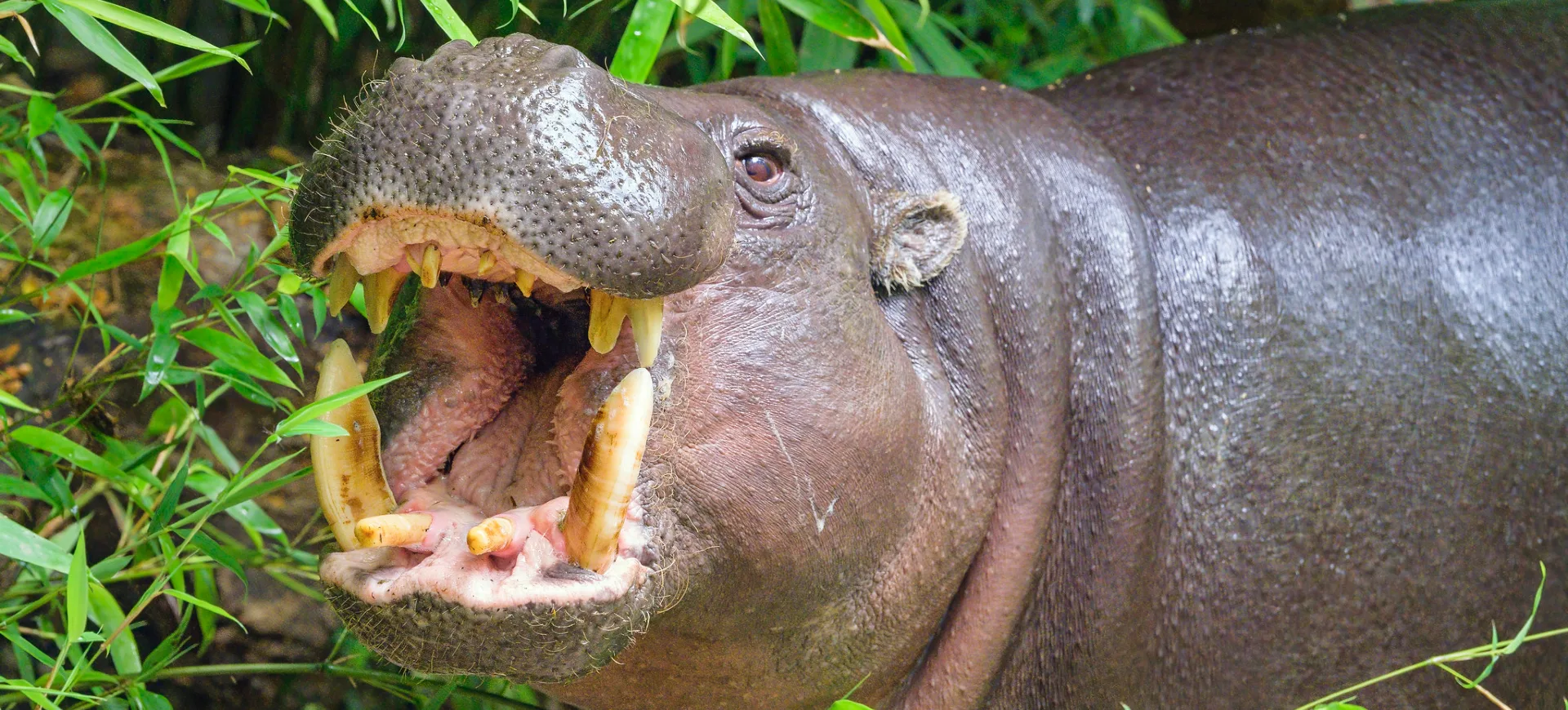Overview
The common hippopotamus (Hippopotamus amphibius), or simply hippo, is a large, mostly herbivorous, semi-aquatic mammal indigenous to sub-Saharan Africa. It is one of only two extant species in the family Hippopotamidae, the other being the pygmy hippopotamus. The name hippopotamus comes from the ancient Greek for 'river horse.' The common hippo is recognizable by its barrel-shaped torso, wide-opening mouth revealing large canine tusks, hairless body, nearly square lateral nostrils, and enormous size.
Adult hippos are large, reaching lengths of 3.5 to 5 meters and weighing between 1.5 and 4 tons. Despite its stocky shape and short legs, it can run 30 km/h over short distances. It is well known for its aggressive nature, and while it is largely herbivorous, it has been known to kill humans and other animals if provoked. The common hippopotamus inhabits rivers, lakes, and mangrove swamps, where territorial males preside throughout the river and groups of 5 to 30 young females.
The common hippopotamus is semiaquatic, spending the day in bodies of water to stay cool and emerging at dusk to graze on grasses. It has several specialized physical features to adapt to its semi-aquatic lifestyle, such as ears, eyes, and nostrils located high on the roof of the skull, enabling the animal to hear, see, and breathe. At the same time, the rest of the body is underwater.
Taxonomy
Kingdom:
Phylum:
Class:
Order:
Family:
Genus:
Species:
Sub Species:
Hippopotamus amphibius kiboko || Hippopotamus amphibius capensis || Hippopotamus amphibius tschadensis
Type:
Physical Description
The Common Hippo, a monumental figure in Africa's freshwater habitats, is widely recognized for its substantial, barrel-shaped body and comparatively short legs. The structure of these semi-aquatic giants is as fascinating as their behavior. Their skin, predominantly hairless, features a unique grayish-purple hue. This skin is a barrier and a source of protection from the harsh African sun, secreting a distinctive pinkish oily fluid often called "blood sweat." This natural sunscreen prevents their skin from sunburn and drying out, a crucial adaptation for their semi-aquatic lifestyle.
Equally intriguing are the hippos' sensory adaptations. The eyes, ears, and nostrils are uniquely positioned high on the roof of their skull. This distinctive arrangement allows hippos to submerge most of their body underwater while maintaining their ability to see, hear, and breathe. Thus, they can monitor their surroundings and potential threats while luxuriating in the water, an essential aspect of their behavior and survival strategy.
-

Lifespan:
Wild: ~40 years || Captivity: ~50 years
-

Weight:
Male: 3300-4000 lbs (1500-1800 kg) || Female: 2900-3300 lbs (1300-1500 kg)
-

Length:
Male: 11-13.3 ft (3.3-4.1 m) || Female: 10-11.5 ft (3.0-3.5 m)
-

Height:
Male: 59-70 inches (150-177 cm) || Female: 55-63 inches (140-160 cm)
-

Top Speed:
20 mph (32 km/h)
-

Characteristic:
Congregatory, Dangerous, Dangerous Animals, Dominance Hierarchy, Giant Animals, Graminivore, Grazing, Herbivore, Highly social, Long-Lived Animals, Natatorial, Nocturnal, Not a Migrant, Polygyny, Precocial, Semiaquatic, Starts with C, Territorial, Viviparous
Native Habitat:
The Common Hippo, a unique mammal known for its semi-aquatic lifestyle, calls the expansive landscapes of sub-Saharan Africa home. These gigantic creatures are highly adaptive and can thrive in various aquatic environments that span the African continent. From the mighty rivers that cut through vast plains to the tranquil lakes nestling amidst the wild, these settings offer ideal habitats for the hippos. They prefer these watery domains for their ability to offer respite from the scorching African sun, enabling them to submerge their massive bodies to stay cool during the day's heat.
In addition to rivers and lakes, Common Hippos also inhabit swamps and wetlands. These habitats, characterized by their dense vegetation and abundant water supply, provide an excellent environment for these giants. The lush greenery offers a plentiful food source but also aids in concealing them from potential threats. These water-bound locations are a crucial aspect of hippo life, allowing them to maintain their unique lifestyle and stabilize their body temperatures amidst the African heat.
-
Climate Zones:
-
Biomes:
-
WWF Biomes:
-
Biogeographical Realms:
-
Continents:
-
Countries:
Angola, Benin, Botswana, Burkina Faso, Burundi, Cameroon, Central African Republic, Chad, Congo, Cote d'Ivoire, DR Congo, Equatorial Guinea, Ethiopia, Gabon, Gambia, Ghana, Guinea, Guinea-Bissau, Kenya, Malawi, Mali, Mozambique, Namibia, Niger, Nigeria, Rwanda, Senegal, Sierra Leone, Somalia, South Africa, South Sudan, Sudan, Swaziland, Tanzania, Togo, Uganda, Zambia, Zimbabwe
-
Diet:
Diet & Feeding Habits:
The Common Hippo, despite its colossal size and potential for aggressive behavior, sustains itself primarily on a diet of vegetation. These semi-aquatic giants are typically herbivorous, with their meals comprising grasses and fallen fruits. Occasionally, they diversify their intake by consuming aquatic plants, adapting to their environment's offerings. Their diet, although fibrous, is generally low in nutrients, necessitating them to graze for extended periods to meet their dietary needs.
Hippos typically exhibit nocturnal feeding habits. When the African sun dips below the horizon and the day's heat fades, these creatures emerge from their aquatic sanctuaries to graze. They can spend roughly five hours each night feeding, consuming an impressive 68 kg of grass. This impressive intake is critical to fuel their sizeable bodies and health.
-
Mating Behavior:
Mating Description:
Common hippos adhere to a polygynous mating system, wherein a single male associates with multiple females. Breeding is typically non-seasonal, although most mating activities occur between February and August. The females usually give birth underwater, often aligning with the rainy season from October to April. After a gestation period of about 240 days, a single calf is born.
The bond between mother hippos and their offspring is profound and characterized by nurturing activities such as grooming and cuddling. Although the calves are fully weaned by the time they're 1.5 years old, they usually stay with their mothers until they're fully independent, around 7-8. Male hippos reach sexual maturity between 7 and 9 years, while females do so slightly later, between 8 and 10 years.
-
Reproduction Season:
Year-Round
-
Birth Type:
-
Pregnancy Duration:
~8 months
-
Female Name:
cow
-
Male Name:
bull
-
Baby Name:
calf
-
Conservation Status:
-
Population Trend:
-
Population:
~115,000 to 130,000
Population Description:
The population of the Hippopotamus, one of Africa's iconic wildlife species, has unfortunately been on a downward trajectory. The causes of this decline are mainly due to habitat loss and hunting. Driven by the increasing human population and expanding settlements, their natural habitats are shrinking alarmingly. Furthermore, illegal hunting for hippo meat is considered a delicacy in some cultures, and the trade of their teeth for ivory exacerbates their survival challenges.
However, despite these threats, hippos can still be scattered across sub-Saharan Africa. Their presence is most prominent within protected environments such as national parks and reserves. These dedicated conservation areas provide a haven for these majestic creatures, sheltering them from poaching and providing a more stable habitat. The continued existence of hippos in such areas is a testament to the pivotal role that these conservation strategies play in preserving diverse wildlife species.
Population Threats:
The Common Hippo, a distinctive inhabitant of sub-Saharan Africa, faces numerous threats, the most prominent being habitat loss. As human populations grow and expand into previously wild areas, these aquatic giants find their natural homes increasingly encroached upon. Deforestation, agricultural activities, and urban development contribute to the rapid loss of their natural habitats. Furthermore, periods of civil unrest in certain regions exacerbate these problems by disrupting conservation efforts and creating unstable living conditions for the hippos.
Illegal and unregulated hunting represents another major threat to the survival of the Common Hippo. Despite international regulations, there is still a substantial demand for hippo meat and their teeth, coveted as a source of ivory. Unregulated hunting to meet these demands is causing a severe decline in hippo populations. These threats, individually and collectively, pose significant challenges to conserving this remarkable species.
Conservation Efforts:
Conservation efforts to protect the Common Hippo are multifaceted, addressing habitat preservation and direct threats to the species. A primary focus is establishing and managing protected areas such as national parks and reserves. These areas provide safe environments where hippos can live without fear of habitat encroachment, offering them the aquatic and grassland environments essential to survival. Maintaining these spaces and ensuring they provide sustainable living conditions for hippos is crucial.
In addition to habitat protection, effective enforcement of hunting regulations plays a pivotal role in conservation efforts. By implementing and upholding strict laws on illegal hunting and the ivory trade, authorities can significantly reduce the direct threat to hippos. Alongside this, initiatives have been developed to mitigate human-hippo conflict, often resulting from overlapping human settlements and hippo habitats. These include community awareness programs and the creation of barriers or alternative pathways for hippos to discourage them from entering human-populated areas.
Fun Facts
- Despite their bulk, hippos can run faster than a human on land.
- Hippos are among the largest living land mammals, slightly smaller than elephants and some rhinoceroses.
- Despite their physical resemblance to pigs and other terrestrial even-toed ungulates, their closest relatives are cetaceans (whales, porpoises, etc.).
- The name Hippopotamus comes from the ancient Greek for "river horse."
- Hippos secrete an oily red substance that acts as a moisturizer, sunblock and protects them from germs. This has led to the myth that hippos sweat blood.
- They are excellent swimmers and can hold their breath for up to five minutes underwater.
- Hippos have a flexible social system defined by hierarchy and food and water conditions.
- A hippo's wide-open mouth is big enough to fit a 4-foot-tall child in.
- Hippo calves weigh nearly 100 pounds (45 kilograms) at birth and can suckle on land or underwater by closing their ears and nostrils.
- Each night, an adult hippo eats up to 80 pounds (35 kilograms) of grass.










Social Structure Description:
Hippos are inherently social creatures, known to congregate in groups and called "bloats." A typical bloat usually comprises 10 to 30 individuals with a complex social structure underpinned by cooperative and competitive interactions. The dominant male, also known as the bull, leads the group, maintaining authority through displays of strength and aggression. This social organization allows them to navigate their aquatic habitats safely and effectively.
These groupings can sometimes expand significantly, with some bloats documented to contain up to 200 hippos. These larger congregations typically occur in regions abundant in resources or during certain periods like the dry season when hippos congregate around limited water sources. These larger boats offer a fascinating glimpse into the societal dynamics of hippos, highlighting their adaptability and resilience in the face of changing environmental conditions.
Groups:
bloat, herd, thunder, pod, school